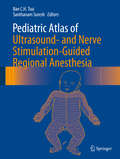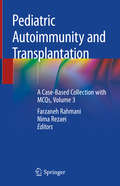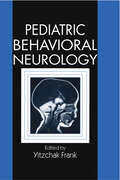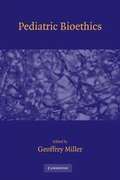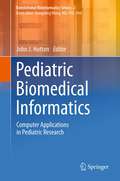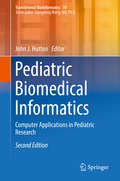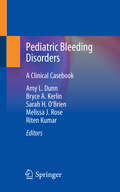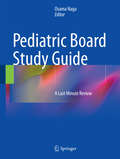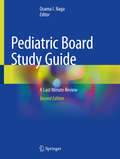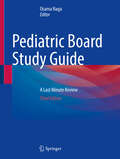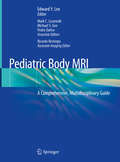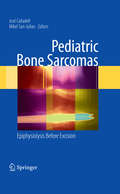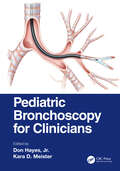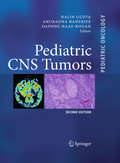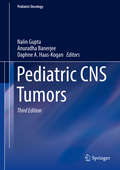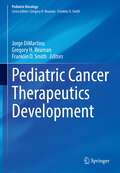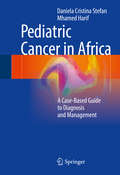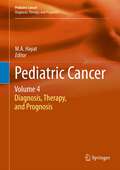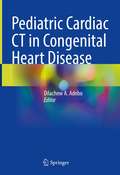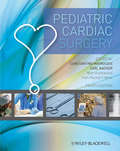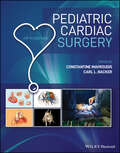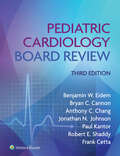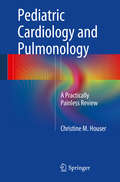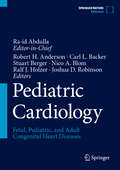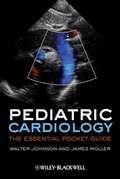- Table View
- List View
Pediatric Atlas of Ultrasound- and Nerve Stimulation-Guided Regional Anesthesia
by Ban C.H. Tsui Santhanam SureshThis is the first comprehensive text-atlas that shows how to use ultrasound technology and nerve stimulation techniques to guide regional blockade in children. Clinical chapters follow a sequential, highly illustrated format that provides step-by-step guidance and include cases, clinical pearls, and troubleshooting tips. Nearly 400 figures, consisting of ultrasound images, MRI images, and schematics, have been assembled to maximize understanding of pediatric neuroanatomy and its relationship to surrounding anatomical structures. To help the novice user, the book features side-by-side presentation of unlabeled and labeled ultrasound images. Pediatric Atlas of Ultrasound- and Nerve Stimulation-Guided Regional Anesthesia focuses on common approaches, supplemented in clinical pearls and notes by alternative approaches, and emphasizes dynamic and systematic scanning techniques. It is intended for pediatric anesthesiologists who wish to incorporate regional blockade into their repertoire and designed as a refresher and resource for all regional anesthesiologists seeking to refine their skills. Unique Selling Points: Internationally renowned experts Presents two technologies proven to improve block success when used together Superb coverage of pediatric anatomy in relation to regional anesthesia Equipment, set-up, pain assessment, local anesthetic pharmacology, and patient safety considerations f or child patients
Pediatric Autoimmunity and Transplantation: A Case-Based Collection with MCQs, Volume 3
by Nima Rezaei Farzaneh RahmaniThis book is a collection of case-based questions, directed towards and meticulously selected to cover the most common and important aspects of pediatric autoimmune disorders. Autoimmune disorders of infancy and childhood, rheumatological disorders, dermatologic autoimmune disorders, autoinflammatory disorders, and clinical immunology in solid organ and hematopoietic stem cell transplantation are among the topics covered. Each chapter starts with a case description followed by a series of 5-6 multiple choice questions (MCQ), presenting the flow from diagnosis to treatment in a step-wise, logical manner. The text guides the reader through the stream of real clinical practice from initial presentation, differential diagnosis, next best step, lab data, and definitive diagnosis to management and adverse effects of therapy. This MCQ format along with precise, yet detailed answer ensure a quick, reality learning to the reader. The book provides a quick guide and hands-on learning experience for pediatricians, hematologists, immunologists, transplant specialists, pulmonologists, as well as PhD and post-graduate researchers around the world.
Pediatric Behavioral Neurology
by Yitzchak FrankThis book assembles, for the first time, information required for the recognition, understanding, and treatment of behavioral problems resulting from neurological conditions. Its focus is two-pronged: 1) on conditions where cognitive-behavioral manifestations are major symptoms, such as attention deficit hyperactivity disorder, autism, and developmental language disorder; and 2) on conditions where these symptoms are significant but secondary, such as brain tumors, epilepsy, and AIDS. This multi-authored guide also outlines effective approaches to behavioral therapy for these conditions. Pediatric Behavioral Neurology is an excellent resource for practitioners whose work demands knowledge of the symptoms, signs, and treatment of behavioral and cognitive disorders caused by brain abnormalities. It is comprehensive, yet concise and easy to use.
Pediatric Bioethics
by Geoffrey MillerThis volume offers a theoretical and practical overview of the ethics of pediatric medicine. It serves as a fundamental handbook and resource for pediatricians, nurses, residents in training, graduate students, and practitioners of ethics and healthcare policy. Written by a team of leading experts, Pediatric Bioethics addresses those difficult ethical questions concerning the clinical and academic practice of pediatrics, including an approach to recognizing boundaries when confronted with issues such as end of life care, life-sustaining treatment, extreme prematurity, pharmacotherapy, and research. Thorny topics such as what constitutes best interests, personhood, or distributive justice and public health concerns such as immunization and newborn genetic screening are also addressed.
Pediatric Biomedical Informatics
by John J. HuttonAdvances in the biomedical sciences, especially genomics, proteomics, and metabolomics, taken together with the expanding use of electronic health records, are radically changing the IT infrastructure and software applications needed to support the transfer of knowledge from bench to bedside. Pediatric Biomedical Informatics: Computer Applications in Pediatric Research describes the core resources in informatics necessary to support biomedical research programs and how these can best be integrated with hospital systems to receive clinical information that is necessary to conduct translational research.The focus is on the authors' recent practical experiences in establishing an informatics infrastructure in a large research-intensive children's hospital. This book is intended for translational researchers and informaticians in pediatrics, but can also serve as a guide to all institutions facing the challenges of developing and strengthening informatics support for biomedical research. The first section of the book discusses important technical challenges underlying computer-based pediatric research, while subsequent sections discuss informatics applications that support biobanking and a broad range of research programs. Pediatric Biomedical Informatics provides practical insights into the design, implementation, and utilization of informatics infrastructures to optimize care and research to benefit children. Dr. John Hutton is the Vice President and Director of Biomedical Informatics at Cincinnati Children's Hospital Medical Center, Cincinnati, OH, USA. He is also Professor of Pediatrics and Associate Dean for Information Services at the University of Cincinnati College of Medicine.
Pediatric Biomedical Informatics
by John J. HuttonThe book describes the core resources in informatics necessary to support biomedical research programs and how these can best be integrated with hospital systems to receive clinical information that is necessary to conduct translational research. The focus is on the authors' recent practical experiences in establishing an informatics infrastructure in a large research-intensive children's hospital. This book is intended for translational researchers and informaticians in pediatrics, but can also serve as a guide to all institutions facing the challenges of developing and strengthening informatics support for biomedical research. The first section of the book discusses important technical challenges underlying computer-based pediatric research, while subsequent sections discuss informatics applications that support biobanking and a broad range of research programs. Pediatric Biomedical Informatics provides practical insights into the design, implementation, and utilization of informatics infrastructures to optimize care and research to benefit children.
Pediatric Bleeding Disorders: A Clinical Casebook
by Amy L. Dunn Bryce A. Kerlin Sarah H. O’Brien Melissa J. Rose Riten KumarThis clinical casebook provides a concise, state-of-the-art review of pediatric bleeding disorders. Presented in a case-based format, each case presents a different variant of bleeding disorder, illustrates the etiology, pathology, genetics, diagnosis, and management of the disorder, and offers clinical pearls. Disorders covered include hemophilia A and B, rare factor deficiencies, von Willebrand disease, immune thrombocytopenia purpura, and platelet dysfunctions. Written by experts in the field, Pediatric Bleeding Disorders: A Clinical Casebook is a valuable resource for clinicians and practitioners treating patients with challenging coagulation issues.
Pediatric Board Study Guide
by Osama NagaCovers the most frequently asked and tested points on the pediatric board exam. Each chapter offers a quick review of specific diseases and conditions clinicians need to know during the patient encounter. Easy-to-use and comprehensive, clinicians will find this guide to be the ideal final resource needed before taking the pediatric board exam.
Pediatric Board Study Guide: A Last Minute Review
by Osama I. NagaBuilding upon the highly successful 1st edition, this book is a comprehensive review designed to prepare pediatric residents, fellows, and pediatricians for the General Pediatrics Certifying Examination, and for the American Board of Pediatrics Maintenance of Certification. Pediatric Board Study Guide: A Last Minute Review, 2nd edition, covers all aspects of pediatric medicine; each chapter has been updated according to the most recent content specifications provided by the ABP. The 2nd edition provides more illustrations, diagrams, radiology images, and clinical case scenarios to further assist readers in reviewing pediatric subspecialties. New chapter topics include nutrition, sports medicine, patient safety, quality improvement, ethics, and pharmacology. Finally, the book closes with a “Last Minute Review” of high-yield cases arranged in the same sequence as the chapters, providing readers with a concise study guide of critical cases and conditions.Pediatric residents and fellows preparing for the board examination, pediatricians, and pediatric subspecialists preparing for certification maintenance will find Pediatric Board Study Guide: A Last Minute Review, 2nd edition easy to use and comprehensive, making it the ideal resource and study tool.
Pediatric Board Study Guide: A Last Minute Review
by Osama NagaThe second edition of this text has proved to be a very successful pediatric study guide, helping many pediatricians around the world to study pediatrics in a very easy, simplified way. Even the most complex subjects are condensed into very straight forward and easy to remember information blocks. This book not only prepares students to pass their exams but also prepares pediatricians for general pediatric encounters, emphasizing all new updates from the American Academy of Pediatrics and American Board of Pediatrics. It has proved very popular among new pediatricians and new pediatric residents worldwide. In the last 3 years, the AAP and ABP have released a lot of updates, such as, management of fever in well-appearing infants, COVID-19, asthma management, and new vaccine guidelines from the CDC. The pediatric board exam always includes new diseases, which are included in each chapter, as well as new questions and answers that must be added to the last-minute review chapter, as well as other questions to be edited to follow the new recommendations and guidelines in pediatrics. New pictures and better quality illustrations are also included. Pediatric residents and fellows preparing for the board examination, pediatricians, and pediatric subspecialists preparing for certification maintenance will find Pediatric Board Study Guide: A Last-Minute Review, 3rd edition, easy to use and comprehensive, making it the ideal resource and study tool.
Pediatric Body MRI: A Comprehensive, Multidisciplinary Guide (The\clinics: Radiology Ser. #51-4)
by Edward Y. Lee Mark C. Liszewski Michael S. Gee Pedro Daltro Ricardo RestrepoThis book is a unique, authoritative and clinically oriented text on pediatric body MRI. It is your one-step reference for current information on pediatric body MRI addressing all aspects of congenital and acquired disorders. The easy-to-navigate text is divided into 17 chapters. Each chapter is organized to comprehensively cover the latest MRI techniques, fundamental embryology and anatomy, normal development and anatomic variants, key clinical presentation, characteristic imaging findings with MRI focus, differential diagnosis and pitfalls, as well as up-to-date management and treatment. Written by internationally known pediatric radiology experts and editorial team lead by acclaimed author, Edward Y. Lee, MD, MPH, this book is an ideal guide for practicing radiologists, radiology trainees, MRI technologists as well as clinicians in other specialties who are interested in pediatric body MRI.
Pediatric Bone Sarcomas
by José Cañadell Mikel San-JulianThis technique was devised in Pamplona more than 20 years ago in 1984. However it took a long time for anything to be actually published (J Bone Joint Surg, 1994) because none believed it was really possible to preserve the joint of the patient. As time has gone on, the technique has aroused an outstanding amount of interest among doctors dealing with bone tumors. Nowadays there are people starting to employ the technique in several countries, and there are many doctors wanting to learn about it. With considerable experience now in the application of this technique, and great interest from many professionals from all over the world, the time is right for a comprehensive rundown of these ideas which will help many children who would otherwise almost certainly be amputated.
Pediatric Bronchoscopy for Clinicians
by Christopher L. PallasThis book is a quick reference guide and atlas for performing bronchoscopy in pediatric patients. It offers a multidisciplinary approach, incorporating the perspectives of pediatric pulmonology, otolaryngology, anesthesiology, and respiratory therapy by outlining important anatomic and physiologic considerations. It describes the basic and advanced techniques in performing flexible, rigid, and special bronchoscopy maneuvers and approaches. This book enhances the reader’s understanding of the critical skill of clinical evaluation and management of the pediatric airway. It is addressed to junior and senior trainees as well as early- and late-career clinicians involved in pediatric bronchoscopy as an on-the-go guide. Key Features: Pays special attention to including widely applicable techniques that can be employed across a variety of domestic and international practical settings, complete with a wealth of accompanying videos and illustrations from real-world experiences that are easy to replicate and reference in practice. Promotes a multidisciplinary approach to the evaluation of the upper and lower airways in children with respiratory and aerodigestive pathology as the lines between pediatric pulmonology, otolaryngology, anesthesiology, surgery, critical care, and emergency medicine are blurring, thus providing well-equipped clinicians with a thorough perspective of all disciplines. Features bullet-pointed lists for pre-procedure evaluation, with procedural checklists, images, and videos, and serves as a portable, compact, and accessible quick reference guide.
Pediatric CNS Tumors
by Anuradha Banerjee Daphne Haas-Kogan Nalin GuptaPediatric CNS Tumors is a detailed review of childhood brain tumors with a particular emphasis on providing treatment algorithms for each tumor type. Controversies and current therapeutic agents under development are also discussed. The second edition includes expanded chapters on embryonal tumors, rare tumor types, and supportive care for patients with brain tumors.
Pediatric CNS Tumors
by Anuradha Banerjee Nalin Gupta Daphne A. Haas-KoganPediatric CNS Tumors is a detailed review of childhood brain tumors that offers a biologically based perspective on their management. For each tumor type, epidemiology, pathological features, clinical presentation, diagnosis, and treatment are discussed. Particular emphasis is placed on the provision of treatment algorithms that reflect current best practice, and controversies and therapeutic agents under development are also addressed. The closing chapters consider many of the diagnostic and treatment modalities common to all tumors, with special attention to experimental and emerging techniques. This third edition of the book has been thoroughly revised and updated to take into account the latest advances in knowledge and treatment.
Pediatric Cancer Therapeutics Development (Pediatric Oncology)
by Gregory H. Reaman Franklin O. Smith Jorge DiMartinoThis book provides a comprehensive overview of the scientific, medical, regulatory, and economic considerations associated with the discovery, development, and delivery of novel therapeutics for children with cancer. Co-authored by a diverse team from academic, government, and industry backgrounds, the book describes the steps in the process from the identification of a promising therapeutic target to the evaluation of drug candidates in the various phases of clinical testing and regulatory review. Throughout, special emphasis is placed on the unique biology of pediatric malignancies and the medical and social needs of children and their families. In providing a firm grounding in the drug development process, the book will be of value to all with an interest in how medicines currently used to treat pediatric cancer were made available. This includes trainees as well as established practitioners and others participating in translational and clinical research in the academic setting.
Pediatric Cancer in Africa
by Daniela Cristina Stefan Mhamed HarifThis text is the only book of its kind to provide specific guidance applicable to limited resource settings and builds up from the foundation of general practitioner or general pediatrician competence. Written and edited by leaders in the field, this manual educates physicians on the essential components of the discipline, filtered through the experience of specialists from developing countries, with immediate applicability in the specific healthcare environment in these countries. Typically, manuals of pediatric hematology-oncology are written by specialists from high-income countries, and usually target an audience with a sub-specialist level of training, often assisted by cutting-edge diagnostic and treatment facilities. However, approximately 80% of new cases of cancer in children appear in mid- and low-income countries. Almost invariably, general practitioners or general pediatricians without special training in oncology will look after children with malignancies who enter the health care system in these countries. The diagnostic facilities are usually limited, as are the treatment options. The survival figures in these conditions are somewhere below 20%, while in high-income countries they are in the range of 80% for many childhood cancers. This book includes simplified therapy protocols, pain therapy and palliation, as well as ward procedures such as bone marrow aspiration/biopsies, intravenous therapy and chemotherapy drugs mixing. It provides an overview of pediatric cancer epidemiology, cancer registration and organizing support networks and features the management of cancers with associated pathology like AIDS, malnutrition, malaria and tuberculosis.
Pediatric Cancer, Volume 3
by M. A. HayatBrain tumors are the most common solid tumor of childhood as well as the leading cause of cancer-related mortality in children. This third volume of the Springer series discussing pediatric cancer focuses on diagnosing, treating, and assessing the future course of malignant brain neoplasms in children. In addition to a general introduction to the principals involved, the material includes vital research in molecular genetics, a major contribution to the molecular characterization of solid tumors, which will define new biomarkers of the disease and identify molecular pathways. Now it has become possible to achieve the goal of targeting new, more effective therapies to minimize the tragedy faced by children. This research features the application of molecular genetics in combating atypical teratoid/rhabdoid tumor (AT/RT), a highly aggressive embryonal CNS tumor that is among the most common malignant neoplasms in children, with a peak occurrence in infants younger than three years old. Contributors also examine the reasons for the common misdiagnosis of AT/RT tumors as other types of CNS tumors. They help resolve this issue by indicating the details of an abnormality in the genetics of AT/RT, which is unique to AT/RT type. The INII gene on chromosome 22q11 is involved in the AT/RT. The presence of this gene and the SMARCB1 is discussed. In addition to discussing these important topics, the volume includes presentations of present and future therapies. The volume also explains AT/RT's dissemination to the cerebral fluid, the molecular mechanisms underlying the progression of medulloblastoma, and the importance of gamma knife radiosurgery during multimodality management of medulloblastoma/PNET tumors. Other topics discussed include using magnetic resonance imaging for diagnosing retinoblastoma, and mapping the effects of radiotherapy in low-grade glioma in children. Information on alterations in cell-cycle regulators that are influenced by tumor suppressor genes and oncogenes is detailed. Contributors provide recommendations concerning non-narcotic analgesic routines for children recovering from cranial and spinal surgery. The practical knowledge of frontier-expanding research presented leads this authoritative volume to be a compelling addition to the literature.
Pediatric Cardiac CT in Congenital Heart Disease
by Dilachew A. AdeboThis book serves as a comprehensive guide to pediatric cardiac computed tomography (CT), particularly for patients with congenital heart disease. Congenital heart disease (CHD) is the leading cause of congenital abnormalities (8/1000 of live births). Over the past two decades, the diagnostic medical approach has significantly changed with a considerable increase in the number of CT studies in pediatric patients. Preoperative surgical or interventional planning for children with CHD remains crucial and challenging, but despite this and the advancement in the development of new CT techniques and radiation dose reduction methods, there are limited books addressing pediatric cardiac CT.This work fills that gap by offering a complete look at the techniques and clinical utilization for pediatric cardiac CT with liberal use of images. The text begins with overarching themes of pediatric cardiac CT, like its advantages and techniques, and moves into covering different areas of the heart and possible presentations, like atrioventricular connections and cardiac tumors. Each chapter begins with a short introduction section followed by preoperative and postoperative cardiac CT imaging, management approach, and short-term and long-term outcomes. This book also describes the novel technologies being used for three-dimensional modelling and three-dimensional printing in the surgical preparation of patients with complex congenital heart disease. This book is the first to address pediatric cardiac CT image fusion to fluoroscopy to guide cardiac catheterization in patients with complex congenital heart disease. Radiation dose reduction during cardiac catheterization is also an important part of diagnostic and interventional cardiac catheterization that is covered in detail. The book concludes with an overarching look of the role cardiac CT plays in the pre- and post-operative evaluation of congenital heart disease in children.This book is an ideal guide for pediatric radiologists, pediatric cardiologists, pediatric cardiothoracic surgeons, related trainees, and any physician interested in advanced cardiac imaging.
Pediatric Cardiac Surgery
by Carl Backer Richid F. Idriss Constantine MavroudisPediatric cardiac surgery is a dynamic, fast-moving field. Busy practitioners, like you, need clear and comprehensive guidance you can rely on to ensure optimal patient care. For over 25 years Pediatric Cardiac Surgery has been the gold-standard reference for pediatric and adult congenital heart surgeons, pediatric and congenital cardiologists, intensivists, anesthesiologists, residents and nurses. Now, in this thoroughly revised fourth edition, you again get trusted, complete coverage of the field with timely new features and expert reviews of critical topics including heart transplantation, emerging modalities for diagnosing congenital heart and tracheal defects, the surgical technique of Fontan conversion with arrhythmia surgery, the medical challenges of managing adult CHD patients, and more. This new edition includes: Contributions from over 65 world-renowned experts More beautiful illustrations, by renowned medical illustrator Rachid Idriss, which have brought acclaim to previous editions Reviews of the embryology, physical findings, diagnostic criteria, and therapeutic choices for each disease entity and describes the latest in surgical techniques in each chapter All-new chapters that guide readers through new treatment options and other key developments since the publication of the third edition highlighting recent advances in congenital heart surgery. All-new new chapters that review advances in right ventricular to pulmonary artery conduits, arrhythmia surgery, double outlet ventricles, and adult congenital heart disease, among other key topics.
Pediatric Cardiac Surgery
by Carl L. Backer Constantine MavroudisPEDIATRIC CARDIAC SURGERY Explore the leading textbook of pediatric cardiac surgery in this easy-to-read and beautifully illustrated volume The field of pediatric cardiovascular surgery includes not only heart surgery for infants and children, but also adult heart surgery to correct congenital heart defects which have been present since birth. As infant mortality from heart defects declines and patients with congenital heart defects live increasingly long and healthy lives, new challenges emerge and as such, the need for introductions to this life-saving field has never been greater. For more than thirty years, Pediatric Cardiac Surgery has met this need with an accessible, comprehensive textbook used by professionals at every level of the field. Featuring full color illustrations, this book offers an introduction to the science of cardiovascular development before moving to detailed analysis of defects in different areas of the heart and their corrective procedures. This updated fifth edition incorporates the latest science to remain the indispensable work on this subject. In Pediatric Cardiac Surgery, 5th edition readers will also find: Contributions from over 75 national and international experts in the field Stunning anatomical illustrations by Rachid Idriss New chapters reflecting cutting-edge research, as well as new material throughout pertaining to cardiac imaging and medical education Pediatric Cardiac Surgery is essential for pediatric and adult cardiac surgeons, cardiologists, and all medical professionals working with pediatric or adult cardiovascular patients.
Pediatric Cardiology Board Review
by Paul Kantor Benjamin W. Eidem Frank Cetta Bryan C. Cannon Anthony C. Chang Jonathan N. Johnson Robert E. ShadeyDesigned to effectively prepare pediatric cardiology fellows and practitioners for board certification and recertification, Pediatric Cardiology Board Review, Third Edition, provides easy access to more than 1,200 board-style questions. Based on the popular Mayo Clinic Pediatric Cardiology Review course and edited by Drs. Benjamin W. Eidem, Bryan C. Cannon, Jonathan N. Johnson, Anthony C. Chang, Frank Cetta, Robert E. Shaddy, and Paul Kantor, it covers all the latest advances in the diagnosis and management of congenital heart disease, provides full explanations for every question, and helps you make the most of your study time.
Pediatric Cardiology and Pulmonology
by Christine M. HouserOften, information in review books can raise as many questions as it answers. This interferes with the study process, because the learner must either look up additional information or skip ahead without truly comprehending what he or she has read. As an alternative, Pediatric Cardiology and Pulmonology: A Practically Painless Review presents bite-size chunks of information that can be read and processed rapidly, helping learners to stay active while studying and to pick up new information the first time they read it. This book's question and answer format allows for self-testing or study with a partner or a group. The format also facilitates dipping into the book during a few minutes of downtime at the hospital or office. Pediatric Cardiology and Pulmonology: A Practically Painless Review is a quick and easy way to master these tricky topics and is suitable for those studying for the pediatric board exam, practicing physicians brushing up their skills, and any busy clinician who wants to learn more about these topics while on the go.
Pediatric Cardiology: Fetal, Pediatric, and Adult Congenital Heart Diseases
by Ra-Id AbdullaThis reference work aims to be the primary resource in the field of heart disease in children and adult congenital heart disease. It contains nearly 100 chapters covering all aspects of heart disease in three populations: fetus with acquired and congenital heart diseases, children with acquired and congenital heart diseases, and adults with congenital heart diseases. Divided into five main sections, the book provides a comprehensive, up-to-date, and continuously revised overview of what is known in the field as well as resources for practical use such as normal values, medication information, and review of published guidelines. The first section of the book includes historical background on congenital heart disease and the evolution of medical, surgical, and catheter therapeutics. The fetal heart disease section comes next and covers cardiovascular embryogenesis, etiological mechanisms, diagnostic tools, presentation and management, cardiomyopathies, arrhythmias, perinatal management, and emergencies. The bulk of the book lies in the third section on pediatric cardiology, which examines not only basic science, assessment, and therapies but also a wide variety of specific acquired and congenital diseases such as valvular lesions, arterial diseases, cyanotic heart diseases, cardiomyopathies, cardiac tumors, and pulmonary hypertension. This is followed by the section on adult congenital heart diseases, discussing echocardiography, electrophysiology, neurodevelopment, and a variety of unique aspects of congenital heart disease in the adult years. The final section of the book focuses on pharmacology with chapters on inotropes, vasopressors, diuretics, and more. Pediatric Cardiology: Fetal and Pediatric Heart Diseases & Adult Congenital Heart Diseases is an essential reference for physicians, residents, fellows, medical students, nurse-practitioners, and allied health professionals in cardiology, pediatrics, cardiac surgery, and imaging/radiology.
Pediatric Cardiology: The Essential Pocket Guide (Core Handbook Series In Pediatrics)
by James H. Moller Walter H. JohnsonA unique and straightforward explanation of complex pathophysiology of cardiac malformations Addresses the important and growing concern of diagnosing heart disease and cardiac problems in pediatric care Provides the skills necessary for today's managed care environment in using the history, physical examination, ECG, and chest X-ray to uncover possible problems and eliminate areas of false concern Topics covered include preventive cardiology and health promotion, heart disease in the neonate and in special populations, congenital cardiac malformation, acquired cardiac conditions, and congestive heart failure
